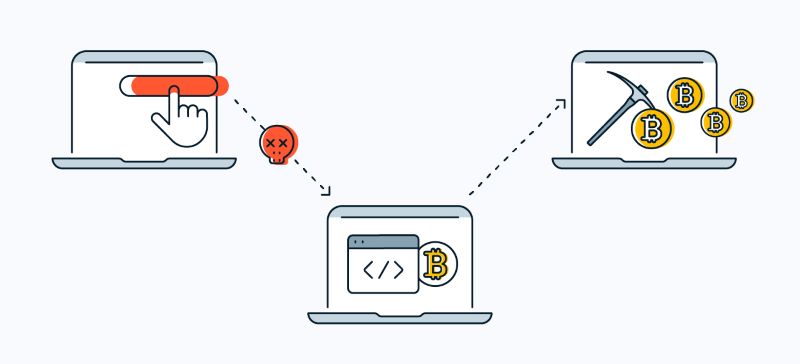Unveiling Coinhive: What’s the Buzz About This Crypto Miner?
Ever heard the buzz around Coinhive and wondered exactly what is Coinhive? Well, it’s time to dive in and unpack the mystery. Coinhive came out as a bold new player in the world of cryptocurrency mining, but not without some raised eyebrows and outright controversy. In this blog post, we peel back the layers of this JavaScript miner that’s made its mark by mining Monero (XMR) right in your web browser. From its mechanics to its polarizing existence, we’ll explore how it operates, the debates it sparked about user consent, its brush with malicious use, and the legal tightrope it walks on. Stay tuned for a walkthrough of Coinhive’s life cycle and what its presence means for the future of web monetization and digital ethics.
Understanding Coinhive and Its Role in Cryptocurrency Mining
What is Coinhive?
Raise your hand if you’ve heard of Coinhive but aren’t sure what it is. Coinhive is a service that lets websites mine digital currency. This means website owners can make money when visitors come to their site. They do this by using a bit of your computer’s power. It’s like turning website traffic into digital coins, neat right?
Coinhive came up with a way to make money without ads. Ads can be annoying, we get it. So they thought, why not use some of the CPU power of the visitors to earn Monero? Monero is a type of cryptocurrency, like Bitcoin, but more private.
Now, this sounds like a smart idea. But there’s a catch. Using Coinhive meant visitors might not know their computer was mining. Not cool, right? They didn’t say yes to this. Many saw this silence as a form of cryptojacking. Cryptojacking is when someone uses your computer to mine without asking. It’s a big no-no in the cyber world.
How Does Coinhive Function for Monero (XMR) Mining?
Alright, let’s break down how Coinhive works for mining Monero. Monero is mined when math puzzles get solved, and this needs a lot of computer power. Coinhive provided a JavaScript miner for this. You add it to your website, and boom, visitors’ computers start solving math puzzles. They didn’t need to install anything!
Coinhive’s script would run when someone visited a website with Coinhive. It used a piece of the visitor’s CPU to mine. This means while you’re browsing, your computer is also working. It’s like multitasking for your PC!
But because this could slow down your computer, some visitors got upset. Picture this: you’re watching a cat video, and your computer starts to crawl. That lag might be Coinhive at work, and your CPU is the stage.
And while you’re thinking, “But is that fair?” – here comes the role of consent. Consent is a big deal. Coinhive was shut down later, but it taught us a lot. We need to ask before we borrow someone’s computer power.
Plus, we learned that not all that glitters is gold. Some bad guys used Coinhive to install crypto miner malware. They put the script on websites without the owners knowing. Now, that’s not playing by the rules.
The buzz around Coinhive was real. It was like a sudden gold rush for the digital age. Some loved it, and some didn’t. What we all agree on is that we must use tech wisely. With great power comes great responsibility, right?
We’ve got to think of the visitors. They should have a fast and safe experience. And we’ve got to think of the website owners. They need to pay the bills. Balancing this takes work. So let’s build the web we all want to be part of, fair and square.
The Impact and Controversy Around Coinhive’s Browser-Based Mining
Evaluating the User Consent and Transparency Issues
Have you heard folks buzzing about Coinhive and its browser mining? Let’s dig in and see why it’s such a hot topic. Coinhive was a service that turned website traffic into Monero, a digital currency, by using visitors’ computers. Now, that sounds like a smart move for website owners, right? They could make money without bombarding users with ads. But here’s the catch — sometimes, Coinhive did its mining without users knowing. That’s where the talk about consent and transparency comes in.
Coinhive explained its purpose, but did it always ask users for permission? Not really. This lack of user consent stirred up a big controversy. Should your computer work for someone else without you saying yes? Most would say no way. That’s what got people talking about Coinhive cryptojacking, where mining scripts run hidden on your device. Folks were unhappy about their CPU being used without consent.
Understanding how Coinhive worked is important. So, if you visited a website using Coinhive, your computer’s processing power got to work mining Monero. That could slow down your device or heat it up. Not cool if you didn’t agree to it. Plus, we have the whole question of fair play. Using people’s resources fair and square means asking first and being clear about what’s happening.
Coinhive’s Association with Cryptojacker Malware
Coinhive wasn’t always the bad guy, but others sure used it like one. Cryptojacker malware would sneak Coinhive’s script onto your computer. Then it’d mine for cryptocurrency on the sly. That’s why malware detection and prevention folks started to flag Coinhive as a potential problem. This kind of unauthorized crypto mining is a real cyber security threat.
Now, picture your antivirus software like a cyber cop. It tries to protect your computer’s power from being hijacked by these greedy miners. This is a big deal because your computer has to work hard for those digital coins, and you should call the shots on that, not some hidden script.
The buzz around Coinhive fueled a deeper look into the world of browser-based mining. What started out as an innovative idea for website owner revenue got twisted into something that could hurt your tech and trust. The big lesson here? Whether it’s Coinhive or another JavaScript miner, being up front with users is key.
Coinhive might be talked about in the past tense now — it shut down in 2019. But cryptojacking and the need for ethical mining practices? They’re still very much in the now. Staying informed and on guard against these sneaky schemes can help keep your device performance solid and your digital pockets safe.
Exploring the Legality and Ethics of Using Coinhive for Website Monetization
Assessing the Legality and Regulation of JavaScript Miners
Let’s get real about JavaScript miners. They’re like tiny workers in your computer. They mine cryptocurrency while you surf the web. Some say this is cool. Others are not so happy about it. Picture this: you’re on a site, and your computer starts to slow down. You might think, “What’s up with that?” Well, it could be a JavaScript miner hard at work using your computer’s power to mine digital currency like Monero (XMR).
Now, you’re thinking, “Wait, is that even legal?” The answer is, it’s complicated. In some places, using JavaScript miners like Coinhive is totally okay. But, it’s got to be done right. Website owners have rules to follow. They need to tell you what’s going on and get your okay. Fair is fair, right?
When folks use these miners without saying, “Heads up, we’re mining,” we’ve got a problem. It’s called cryptojacking, and it’s a big no-no. It’s like someone taking your bike without asking. Not cool. That’s why the law steps in sometimes. It says, “You’ve got to play nice and tell people what you’re doing.”
The Necessity of Ethical Mining Practices and User Experience Considerations
Now, let’s chat about being on the up and up with mining. Doing things the right way is a must. Think about it. Your site visitors are like guests. You wouldn’t want to use their stuff without asking. The same goes for using their computer’s power. You’ve got to ask first!
Here’s the scoop: Being straight with your visitors is not just nice; it’s smart. Let’s say you’re a website owner. You want to make some cash, but those ads are just not cutting it. You think about mining to make money. You could put in a miner script, but hold up. You need to think about your visitors, too. If your site makes their computer drag like a snail, they won’t stick around. That means no more money for you.
So, what’s a website owner to do? Well, they could find other ways to make money. They could use ads that aren’t annoying. Or maybe find a script that’s nice and clear about what’s going on. And if they do use a miner, they have to make sure it’s not messing up the visitor’s day.
Long story short, using Coinhive or any other miner has to be done right. You tell folks what’s up, get their okay, and don’t hog all their computer’s power. Also, remember that Coinhive shut down its service. So if someone’s still using Coinhive, that’s a big red flag.
Doing things the right way keeps everyone happy. Visitors get a smooth ride on your site. And you, the website owner, can still make some coin. It’s all about balance and being cool to your digital pals.
Alternatives and Solutions in the Post-Coinhive Era
Transitioning to Legitimate Mining Scripts and Revenue Models
When Coinhive closed shop, website owners felt a jolt. They needed new ways to make money without ads. But what’s next without Coinhive? It’s simple! Websites can still make money and not annoy users with ads. They can use clean mining scripts and be upfront with visitors.
Step one for site owners is clear. Choose scripts that don’t harm user devices or hide from them. The goal is to find a balance. Websites need income, and users want a good time online, without their gear slowing down.
What are the clean scripts to use? Look at alternatives like AuthedMine. It was Coinhive’s good twin. It made sure users said “okay” before mining. People’s trust comes first. This way, everyone wins. Websites earn and visitors give the green light first.
Digital coins still need mining. It can happen clean and fair. If you own a site, think of this. Only run scripts after getting an okay from your visitors. Keep them in the loop. Give them control over CPU use for mining. This builds trust and keeps your site safe from harm.
Fighting Back: Tools and Techniques for Detecting and Preventing Cryptojacking
Now, let’s talk about keeping bad miners out. Cryptojacking is a big deal. It means someone’s using your device to mine coins without you saying yes. This can slow your device down and it’s not fair.
So, how do you fight back against cryptojacking? First, stay sharp online. Keep your eyes open for signs like your device slowing down for no reason. That could mean someone’s mining on the sly.
Then, arm yourself with good tools. Anti-virus software knows how to spot sneaky miners. They scan your device and keep it clean. Using browser extensions for block mining is smart, too.
Also, if you run a website, you have to watch out. Make sure your site’s free from hidden miners. This means regular checks. Good cyber security keeps your site safe, and your visitors happy.
Do this and you can keep mining fair. You can stop bad guys grabbing your power for their gain. Instead, steer them to good scripts that ask before they mine. It’s all about respect and playing fair. It’s about a web that works well for everyone.
To sum it up, always stick to clean mining and keep your defenses up. That way, you keep the web great and make sure your gear stays quick and lasts longer.
In this post, we dove into Coinhive and its place in mining for Monero. It started out as a tool but grew complex with issues of consent and malware links. We also talked about how it sits with the law and the need for ethical mining. Even with Coinhive gone, the surge in other mining scripts and ways to stop hackers is big news.
So, what’s my take? We must balance tech advances with user rights and clear rules. Website owners should think hard before using such scripts. And we all need to stay sharp and safe online. Trust is key—let’s build it with smart choices and respect for each other. That’s it – let’s keep our digital world fair and clean for everyone.
Q&A :
What exactly is Coinhive?
Coinhive was a service that allowed website owners to embed a cryptocurrency miner into their site, using the processing power of visitors’ computers to mine Monero (XMR), a digital currency. It provided JavaScript miner for the Monero Blockchain that website owners could embed in their websites.
How did Coinhive work?
Coinhive worked by providing webmasters with a small piece of JavaScript code to be embedded in their websites. When visitors accessed the website, the Coinhive script would run, using a portion of the visitors’ CPU power to mine Monero cryptocurrency, which would then be credited to the site owner’s account.
Why did Coinhive shut down?
Coinhive announced its shutdown in early 2019, citing a significant drop in the hash rate after the last Monero hard fork, changes in the cryptocurrency market, and the increasing unfavorability of economic conditions. Essentially, the service became less profitable and more controversial, leading to its closure.
Was Coinhive considered malware?
Coinhive was not originally designed as malware, but due to its nature, it became associated with malicious activities. Some used it without consent from website visitors, effectively making it a cryptojacking tool. Due to this misuse, it was often detected and blocked by anti-virus and anti-malware software as potentially harmful.
How can one detect if a website uses Coinhive or similar miners?
To detect if a website uses Coinhive or similar cryptocurrency miners, one can monitor the computer’s CPU usage while visiting the site. A significant spike may indicate mining activity. Additionally, browser extensions and security programs can help identify and block such scripts. It is also recommended to read the website’s privacy policy or terms of service, as ethical site owners should disclose the use of such scripts.




RELATED POSTS
SonicX Airdrop – Exciting Tap-to-Earn Gaming Experience
SonicX airdrop offers an incredibly...
How to Backup Your Crypto Wallet: Secure Your Digital Fortune Today
"How to backup your crypto...
What is Optimism? A promising Layer 2 solution for Ethereum
Ethereum is facing scalability challenges,...
Cost of Crypto Hacks: Are Your Investments Really Safe?
Understanding the financial impact of...
Blockchain Prediction Market: Navigate the Future, Bet on Outcomes
Blockchain Prediction Market: Explore Decentralized...
Future Applications of Blockchain Technology: Beyond Bitcoin to Bold Innovations
Future applications of blockchain technology:...
Dawn Airdrop – Unique Reward Mechanism and How to Participate
Dawn Airdrop stands out with...
How does Robinhood work? The Gateway to Blockchain
In today’s rapidly evolving financial...
Explanation of Proof of Work: How PoW Secures Blockchain Innovation
Explanation of Proof of Work...
Comparative DAG vs Blockchain: Decoding the Future of Tech Networks
Compare the Structural Differences: DAG...
Blockchain Basics: Unlocking the Mysteries of Modern Cryptography
Understanding the Cornerstones of Blockchain...
How to Choose a Crypto Wallet: Secure Your Digital Fortune
How to choose a crypto...
Security of Proof of Work: Is Your Cryptocurrency Safe?
Security of Proof of Work...
James Seyffart: A leading expert on ETFs and Cryptocurrency
James Seyffart is a prominent...
Unlocking Blockchain Safeguards: Why User Education is Crucial
The Importance of User Education...
On-Chain Analysis Drawbacks: What Investors May Be Overlooking
Discover the disadvantages of on-chain...